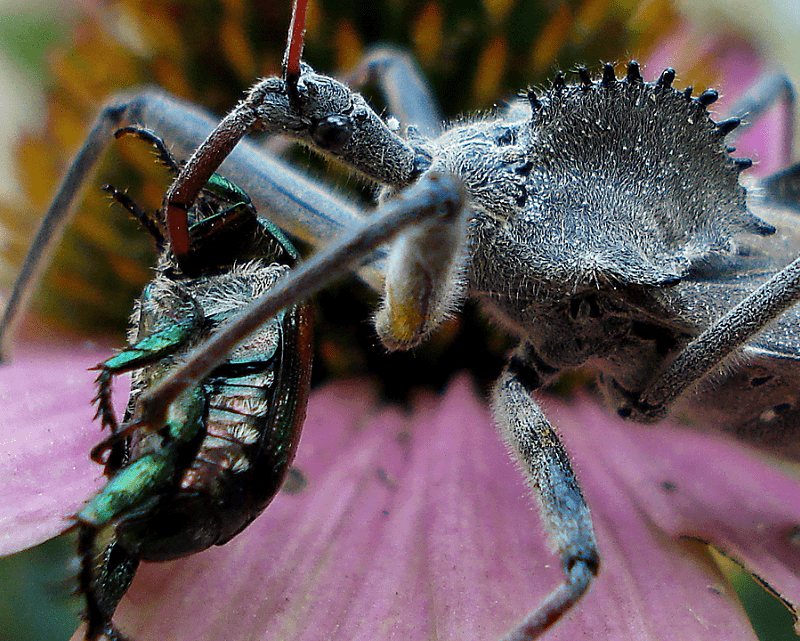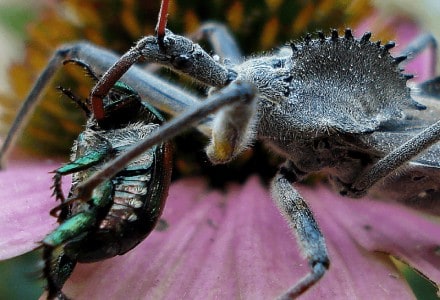
Wheel Bug Facts
- Perhaps most notably, the attention-grabbing term of Wheel Bug remains quite unique. It also serves as the accepted common name of a particularly distinctive member of a scientific classification Family known as Assassin Bugs.
- Although most people refer to all insects as bugs, only species placed within the scientific Order of Hemiptera represent true bugs. Furthermore, this specific species actually ranks as one of the largest of the known true bugs in its habitat range.
- In addition, it actually remains extremely common and numerous in the areas it inhabits. However, despite this fact, the great majority of people never see the creature, or even know of its existence. This primarily occurs due to a combination of two factors.
- Firstly, this remarkable creature possesses a very shy temperament, regardless of its appearance. Secondly, it also ranks as a master of camouflage. However, those who do know of its presence quite often actually welcome its presence.
- This fact, though surprising to some people, holds true because it feeds as a voracious predator of many species considered damaging pests by farmers and gardeners. In fact, its favorite prey includes Japanese Beetles and caterpillars.
- As a result of its dietary habits, this impressive invertebrate remains considered as highly beneficial, and welcomed, by some. Thankfully, therefore, the fascinating Wheel Bug appears to be maintaining a significant and stable population.
- As a result of this fact, the IUCN presently has no listing for it on the Red List of Threatened Species Nonetheless, it may be considered to be at potential risk. Like other species, its main threat most likely consists of the danger posed by climate change.
Related Articles
Magicicada Giant Mesquite Bug Oak Treehopper
Wheel Bug Physical Description
Without doubt, the sincerely amazing species known as the Wheel Bug possesses a most distinctive physical appearance. This fact alone gives it a certain impressive status. It makes this unique work of Nature stand out from its many related species.
However, this remarkable invertebrate also fully merits attention and appreciation for yet another reason. That occurs due to its sheer physical size. That holds true because it forms one of the largest terrestrial bugs in its endemic range.
But, this incredible species does display a relatively slight degree of the physiological trait of sexual dimorphism. Further, in the case of this particular arthropod, this manifests itself in the fact that males attain a slightly larger size than females.
Overall, though, the great majority of mature adults of this truly astounding invertebrate all remain relatively small, at least in relation to other forms of life. To be more precise, individuals typically attain a total body length measuring about 1.5 in (3.8 cm).
Yet the most easily recognized feature of the Wheel Bug remains the cog-shaped structure on its pronotal chitin. The precise function of this feature remains a mystery. That’s despite its being a subject of some investigation by researchers.
In addition, its highly notable proboscis grows highly elongated and folds under when not in use. The wings also stay small, making individuals comparatively poor fliers. The coloring also seems to be a random combination of gray, brown, and black.
- Kingdom: Animalia
- Phylum: Arthropoda
- Class: Insecta
- Order: Hemiptera
- Family: Reduviidae
- Genus: Arilus
- Species: A. cristatus
Wheel Bug Distribution, Habitat, and Ecology
Most unfortunately for those who appreciate Nature, the quite impressive Wheel Bug inhabits a limited, and highly broken, habitat range. That holds true due to the still unexplained fact that it only appears in three restricted, and scattered, regions of the world.
First of all, the greatest majority of its population appears in the eastern regions of the United States, in North America. However, the fabulous arthropod also appears in scattered populations in Mexico, and the country of Guatemala, in Central America.
But, in all regions it appears in, the remarkable invertebrate has very specific needs. In point of fact, it only lives in areas with a very specific habitat. That’s because it only appears to live on certain fruit trees, locust trees, sunflowers, cotton, and goldenrod.
Further, in terms of temperament, this creature remains quite shy and mild mannered. However, if disturbed, the Wheel Bug nonetheless remains capable of delivering a very painful bite to any human that disturbs it, unintentionally or not.
Although it has no toxins, the feeding enzymes injected during the biting process have comparatively strong and long-lasting effects. In point of fact, such bites frequently require several months to heal, and sometimes leave behind an unsightly scar.
Species Sharing Its Range
Opossum Carolina Silverbell Lovebug
Check out our other articles 4 Stupendous Stick Insects, Guinan cock-of-the-rock, McMurdo Dry Valleys, Lady’s Slipper Orchid, Numbat, Basking Shark, Olive Ridley Sea Turtle

